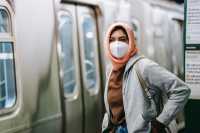
11 Feb Which Subway Systems Have the Most Polluted Air?
MedicalResearch.com Interview with:

Dr. Gordon
Terry Gordon PhD
Professor, Department of Environmental Medicine
NYU Grossman School of Medicine
NYU Langone Health
MedicalResearch.com: What is the background for this study?
Response: We are air pollution researcher and interested in unique exposure scenarios. Based on the work by Dr. Steve Chillrud, Columbia University, we did a study 5 years ago to assess air quality in over 30 subway stations in NYC. We found poor air quality in all of the underground stations but the air quality was better in some locations. So we wondered what would be air quality in different transit systems in NE United States. David Luglio, pre-doctoral candidate, led a team of students to monitor particles in the air of subway stations in metropolitan NYC’s MTA, LIRR, and PATH systems, Boston, Philadelphia, and Washington, DC.
MedicalResearch.com: What are the main findings?
Response: We found that particle concentrations in the air were several to many times higher than outdoor levels in the subways stations in all 4 cities. The worst air quality was measured in NYC/NJ’s PATH system.
MedicalResearch.com: What should readers take away from your report?
Response: Readers should consider that they are exposed to very high levels of air pollution while using subway transit systems. Because the exposure times are often short, there are not likely to be adverse health effects in healthy people, but there is more concern for those with chronic lung or heart disease. In particular, workers may be of the most concern because of the extended length of time they spend underground.
MedicalResearch.com: What recommendations do you have for future research as a result of this work?
Response: We plan to study the toxicity and composition of particles collected in the subway systems. Also, we also need to identify the sources of the particles and get cooperation from transit authorities to reduce these emissions. This would lead to important steps for ‘cleaning the air’. Switching to battery driven maintenance/repair engines, instead of diesel locomotives, is a start. Increasing the ventilation or filtering out air particles would be another, but costly, approach.
Citation:
David G. Luglio, Maria Katsigeorgis, Jade Hess, Rebecca Kim, John Adragna, Amna Raja, Colin Gordon, Jonathan Fine, George Thurston, Terry Gordon, M.J. Ruzmyn Vilcassim. PM2.5 Concentration and Composition in Subway Systems in the Northeastern United States. Environmental Health Perspectives, 2021; 129 (2): 027001 DOI: 10.1289/EHP7202
[subscribe]
[last-modified]
The information on MedicalResearch.com is provided for educational purposes only, and is in no way intended to diagnose, cure, or treat any medical or other condition. Always seek the advice of your physician or other qualified health and ask your doctor any questions you may have regarding a medical condition. In addition to all other limitations and disclaimers in this agreement, service provider and its third party providers disclaim any liability or loss in connection with the content provided on this website.
Last Updated on February 11, 2021 by Marie Benz MD FAAD
